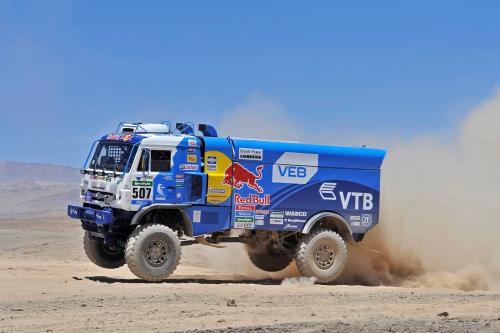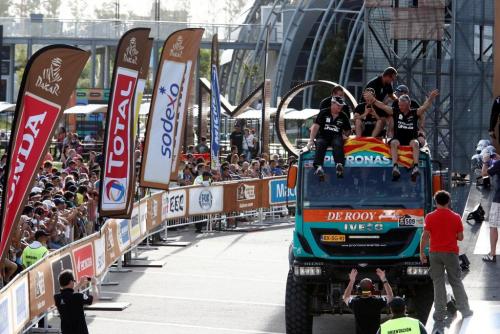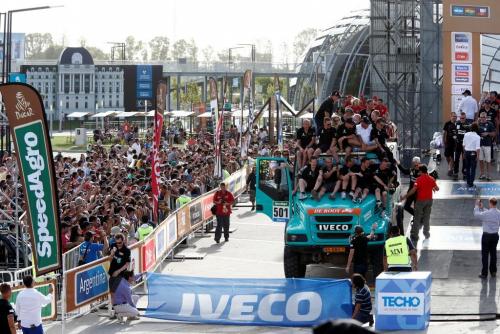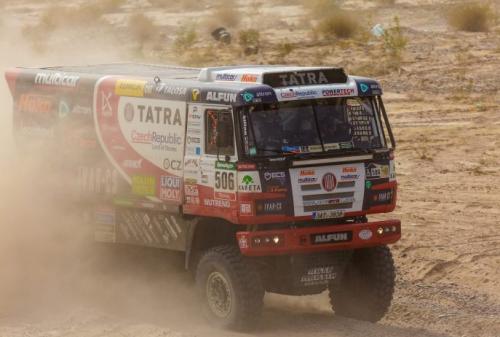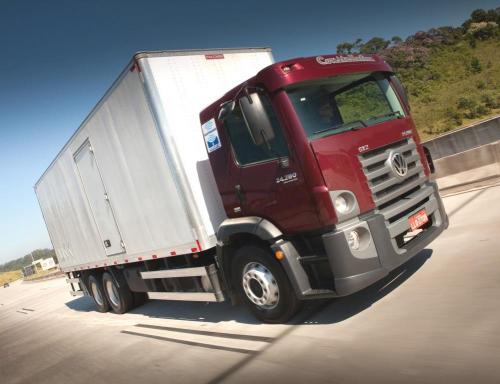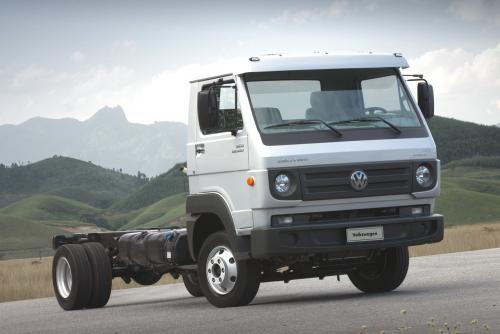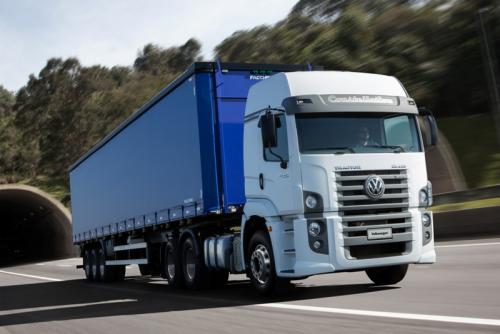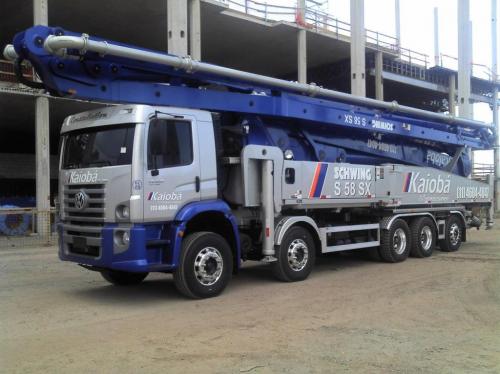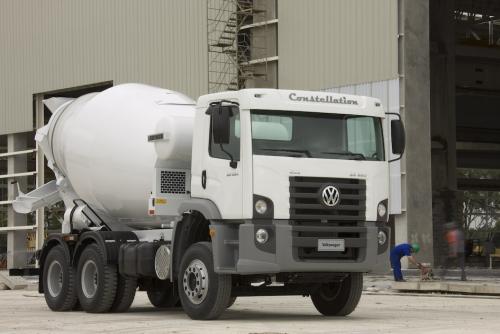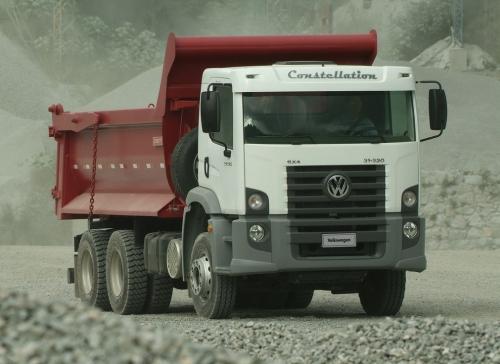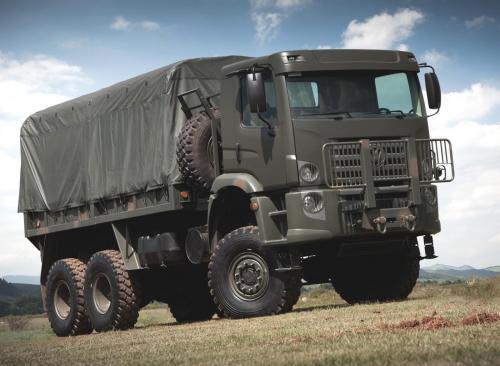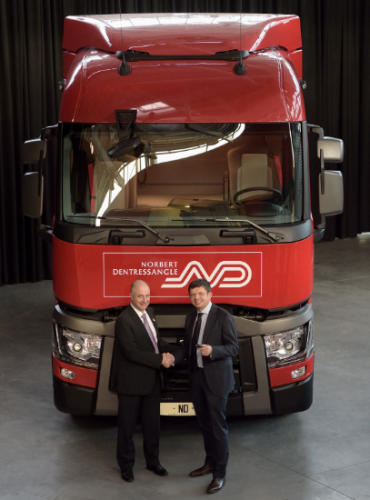
kscarbel2
Moderator-
Posts
18,538 -
Joined
-
Days Won
112
Content Type
Profiles
Forums
Gallery
Events
Blogs
BMT Wiki
Collections
Store
Everything posted by kscarbel2
-
Detroit Free Press / January 20, 2015 Ian Wright and a few tech-minded buddies got together about a decade ago bent on creating a fast and cool electric car. They called the company Tesla Motors. Wright left soon after Elon Musk took Tesla's financial steering wheel in 2004, but now he's back and determined to electrify a slow and ungainly automotive beast: the commercial truck. While the idea might sound crazy, Wright's logic and math are intriguingly simple. "Besides the fact that modern cars are already very clean, your average Toyota Camry driver only uses about 600 gallons a year, while a garbage truck will use 14,000," says Wright, a soft-spoken New Zealander with a passion for sports cars. "It makes the most economic sense to focus energies on a sector where you can displace the most fuel," especially true now that gas has plummeted to under $50 a barrel, says Wright. "When you switch a garbage truck to electric power, you're saving about $60,000 in fuel and $30,000 in maintenance a year." Companies gradually are buying Wright's pitch. His electric powertrain start-up, Wrightspeed, last year contracted with FedEx to retrofit 25 of its medium- to heavy duty-trucks with battery-powered engines that can be recharged through regenerative braking or by small turbines fueled by natural gas or propane. More recently, Wright got the green light from The Ratto Group, a Bay Area garbage and recycling company, to convert 17 of its garbage trucks. In California, such decisions are being spurred by changes to the state's strict California Air Resources Board standards. Certain high-polluting older and heavier commercial trucks had to be off the road by this past Jan. 1, and by 2023 nearly all trucks and buses will need 2010 model year-or-newer engines. In anticipation of increased demand for his services due to CARB's guidelines, Wright announced today that he is moving his 23 staffers from a 30,000-square-foot plant in San Jose to a 110,000-square-foot former Pan Am airplane hangar in Alameda, near Oakland. He anticipates the company's staff growing tenfold by 2018. For Lou Ratto, letting Wrightspeed revamp a group of 2003-2007 garbage trucks was "an opportunity to take myself out of the air-quality conversation," adding that while he's been keen to buy the latest in green trucks, "it's been a struggle" to keep up with CARB requirements. "What I love about this option is that it's true recycling, because we can maximize the life of the truck's bodies while getting a cost savings and environmental benefit," he says. "As for Ian, his Tesla background speaks for itself." Wright is talking about the 2.2 million medium-duty trucks consuming some 35 billion gallons of gasoline a year, as well as those noisy garbage-swallowing banes of urban and suburban existence. Beyond the savings on fuel and frequent brake replacements — Wrightspeed-equipped trucks mainly use regenerative braking to stop — Wright promises a reduction in noise during those early morning pickups. "Most of that racket is the engine revving up to allow the truck's hydraulics to compress the garbage, but that will drop drastically with our engines," he says. The most modern garbage trucks can cost a city upwards of $500,000. Wright says he can retrofit a truck with his cost- and noise-reducing engine for "a huge fraction of that price," typically under $200,000. "What you'd save on fuel and maintenance over the next four years would get that money back," he says. Wright is convinced that electric power ultimately will make a bigger splash by cleaning up the world's commercial vehicles than it will by ferrying around average citizens in often pricey machines. Wright himself doesn't drive a Tesla. He's actually more of a Maserati and Caterham 7 guy. But he has nothing but praise for Musk's stewardship of the company he dreamed up with Martin Eberhard, Marc Tarpenning and J.B. Straubel. "What Tesla has achieved in terms of changing people's perceptions about electric cars, from golf carts to vehicles that compete with Mercedes and Porsche, is beyond my wildest dreams," says Wright. "That said, we're going after high polluters, and in that sense our economic proposition could allow us to scale bigger than Tesla."
-
Oil Declines From One-Week High to Near $50 a Barrel
kscarbel2 replied to kscarbel2's topic in Trucking News
Diesel drops below $3 for first time since 2010 Commercial Carrier Journal (CCJ) / January 20, 2015 The national average price for a gallon of on-highway diesel fell below the $3 mark for the first time since September 2010 and its lowest point since the week ended Sept. 6, 2010, according to numbers released Jan. 19 by the Department of Energy. The U.S. average at-pump price for diesel dropped 12 cents in the week ended Jan. 19 to $2.933 a gallon, according to the DOE. The price is now down 94 cents from the same week last year and has fallen nearly 70 cents since the beginning of December. All regions in the U.S. saw big drops, too, led by a 15.2-cent decline in the West Coast less California region. The Rocky Mountain regional average dropped 14.3 cents, the second biggest drop. The California subregion had the country’s most expensive diesel, $3.165 a gallon, followed by the Central Atlantic’s $3.131. The West Coast less California region had the country’s cheapest diesel, $2.826, followed by the Gulf Coast’s $2.843 and the Rocky Mountains’ $2.884. -
Transport Topics / January 20, 2015 Oil declined from a one-week high in London and New York as Iraqi production advanced to a record, compounding a global supply surplus. Prices slid as much as 2.2% in New York and London after their first weekly gain in two months. Iraq is pumping at an unprecedented pace of 4 million barrels a day, Oil Minister Adel Abdul Mahdi said. Oil extended losses after Chinese shares plunged the most since 2008 as regulators cracked down on margin lending. Crude slumped almost 50% last year as the U.S. pumped oil at the fastest rate in more than three decades while the Organization of Petroleum Exporting Countries resisted calls to cut supply. Iraq’s oil production rose to a 35-year high in December and could break more records in the coming months, according to the International Energy Agency. “With supply exceeding demand, it still seems highly likely that the market will fall further,” Christopher Bellew, senior broker at Jefferies International Ltd. in London, said by e-mail. “Rallies above $50 have proved very short-lived, and my expectation is for the price to move in a sideways range until the next move to the downside, which I expect to take the price to $40 or lower.” Brent for March settlement slid as much as $1.12 to $49.05 a barrel on the London-based ICE Futures Europe exchange. It gained 3.9% to $50.17 on Jan. 16, the highest settlement since Jan. 8. The European benchmark crude was at a premium of $1.05 to WTI for the same month. West Texas Intermediate for February delivery, which expires Jan. 20, dropped as much as $1.07 to $47.62 a barrel on the New York Mercantile Exchange. The more active March future fell as much as $1.08 to $48.05. The volume of all futures traded was 66% below the 100-day average for the time of day. Prices rose 0.7% last week. Iraq plans to increase crude exports to 3.3 million barrels a day this year, including sales from the semiautonomous Kurdish region in the north, Abdul Mahdi said. The OPEC producer exported 2.94 million barrels a day in December, the most since the 1980s, Oil Ministry spokesman Asim Jihad said Jan. 2. In Saudi Arabia, OPEC’s biggest producer, oil exports rose to a seven-month high in November, when it led the group to keep its production quota unchanged. Overseas shipments climbed to 7.3 million barrels a day from 6.9 million in October, according to data on the website of the Joint Organisations Data Initiative. OPEC, which supplies about 40% of the world’s oil, maintained its collective target of 30 million barrels a day at a meeting Nov. 27. The 12-member group pumped 30.2 million a day in December, according to estimates compiled by Bloomberg News. U.S. producers idled a record number of drilling rigs during the past six weeks, according to data from Baker Hughes Inc . on Jan. 16. The number of operating oil rigs in the United States has declined by 209 since Dec. 5, the data show. The count was down 55 in the week ended Jan. 16 to 1,366. U.S. output rose to 9.19 million barrels a day through Jan. 9, the fastest pace in weekly records dating to January 1983, data from the Energy Information Administration show.
-
If your shift knob is leaking air, you can rebuild it with a Mack 14RC1131 shift knob repair kit.
-
The Guardian / January 18, 2015 All the best images from the final six stages of this year’s Dakar Rally, as it winds its way across 5,600 miles through Argentina, Chile and Bolivia. The event is one of the most spectacular in world sport, with drivers and a variety of vehicles tackling an incredible array of terrains, from deserts to flooded rivers. Click here to check some breathtaking images from the first seven stages of the 2015 rally, and here for some archive images from the early years of the Paris-Dakar Rally. http://www.theguardian.com/sport/gallery/2015/jan/18/dakar-rally-2015-stages-8-13-in-pictures#img-1
-
- 1
-

-
KamAZ takes 1st, 2nd and 3rd place at 2015 Dakar
kscarbel2 replied to kscarbel2's topic in Trucking News
Dakar: Ayrat Mardeev finishes off first Dakar title in trucks NBC Sports / January 17, 2015 Ayrat Mardeev has won his first Dakar Rally and the 13th for the dominant KAMAZ team in the truck category following a third-place showing in Sunday’s rain-shortened final stage. KAMAZ locked out the overall podium with Mardeev topping Eduard Nikolaev by 13 minutes, 52 seconds. Coming in third was 2014 Dakar winner Andrey Karginov at 51 minutes off the pace. Nikolaev may well be wondering if it would have been him on the top step in Buenos Aires if not for a turbo-charger failure on his truck in Stage 7 that cost him more than an hour. A win in Stage 8 and runner-up in Stage 9 brought him back up to second place overall behind Mardeev, and it appeared he had the momentum behind him again. But even with another victory in Stage 10, it did next to nothing in bringing him closer because Mardeev finished second that day at a mere 49 seconds back. That proved critical for Mardeev, who would manage his lead with finishes of ninth, fifth, and third in the remaining stages to take the crown for himself. Nikolaev may have led all truck drivers with six stage wins, but Mardeev’s consistency won out. As for Stage 13, Hans Stacey pulled off an impressive third consecutive stage win to end his Dakar the same way he started it. Stacey and his Iveco out-hustled the MAN of Marcel Van Vliet by 1 minute, 21 seconds. Video: http://motorsportstalk.nbcsports.com/2015/01/17/dakar-ayrat-mardeev-finishes-off-first-dakar-title-in-trucks/ -
Prime Mover Magazine / January 19, 2015 The 2015 Dakar rally concluded on Saturday in Buenos Aires with a triple win by Russia’s KamAZ brand. The company’s Master race trucks crossed the finish line in first, second, and third place. The 2015 edition of the world-famous event, which originated on the African continent, was the rally’s seventh consecutive year to be held in South America. The route covered 9,000km (5,592 miles) in Argentina, Bolivia and Chile, crossing the Andes Mountains and racing the Salar de Uyuni, the world’s largest salt lake, before venturing in the Atacama Desert, commonly known as the driest place on Earth. In total, 63 racing trucks representing twelve different commercial vehicle brands competed in the Dakar 2015 rally. KamAZ sent four trucks to successfully defend its title. The winning trucks were supported by several key suppliers, including Belgian juggernaut Wabco, which has provided KamAZ’ heavy-duty race trucks with high-performance air compressors, wheel-end solutions, coupling controls and brake cylinders. “The Dakar Rally represents two grueling weeks in the most challenging terrain on Earth. It is the ultimate test for trucks and teams alike”, said Vladimir Chagin, director of NP KamAZ-Avtosport, leader of the KamAZ Master team. Stage 13 (Final) Overall Ranking: http://www.dakar.com/dakar/2015/us/stage-13/rankings/overall-trucks.html Team KamAZ: http://www.kamazmaster.ru/en Redbull (Like father, like son): http://www.redbull.com/en/motorsports/offroad/stories/1331700349831/ayrat-mardeev-2015-dakar-rally-champion-interview-story Wabco: http://www.wabco-auto.com/nc/media/media_center/press_releases_wabco/press_releases_single_view/news-article/kamaz-master-truck-racing-team-defends-championship-title-at-dakar-rally-2015-supported-by-wabcos-h/ .
-
Press Release / January 19, 2015 After a shorter final stage, the surviving 2015 Dakar teams reached the competition finish line in the town of Baradero, 150 kilometers from Buenos Aires. Iveco's Hans Stacey, who also won the last special stage, and Gerard de Rooy arrived in the Top 10 after a tough race that presented problems for most pilots along more than 9,000 kilometers. A new edition of the toughest competition in the world came to an end. The 2015 Dakar announced the champions upon arrival in Baradero, near Buenos Aires, the site of the symbolic podium. Hans Stacey was the first truck to leave and took advantage of the clear road to win another stage in the 2015 Dakar. This is his third consecutive victory. He achieved a total of four, including the one on the first day of the competition. The Dutchman, with an Iveco Powerstar, beat his countryman Marcel van Vliet by 1m19s and the 2015 Dakar champion, Airat Mardeev, by 2m25s. Gerard de Rooy finished the day in 7th place with his Iveco Powerstar at 4m36s of the leader and he moved up another position during the final kilometers to finish 9th overall. The Dutchman was one of the competition favorites, but problems in the fourth stage when he crashed in a ditch made it impossible to fight for overall victory. Regardless, De Rooy always kept pace with the leaders and repeatedly took the podium during the various stages. However, this is the first Dakar he finishes without winning a stage since 2011, when he pulled out in the first stage. Pep Vila, with his unerring Iveco Trakker Evolution II, finished today in 12th place, 9m24s behind his winning teammate Hans Stacey. Even though he was unable to achieve his goal of reaching the top 10, the Spaniard finished with a clear conscience, since he helped Gerard De Rooy to stay in the race. If he had not lost that time in stage 4, Pep Vila could have finished in the Top 10. Pierre Lahutte, President of the Iveco brand, was present at the closing of the 2015 Dakar, alongside the fleet that arrived in Buenos Aires. "Our three trucks arrived at the finish line confirming their reliability and durability in the most extreme conditions. We did not end up on the podium as we had hoped, but we persevered and won the last three stages of the Dakar. Congratulations to the whole team," concluded Pierre Lahutte. See more at: http://www.iveco.com/Dakar/Pages/The-2015-Dakar-is-over-with-two-Iveco-drivers-in-the-Top-10.aspx#sthash.u0ru3CsQ.dpuf http://www.dakar.com/dakar/2015/us/ .
-
Truck News / January 19, 2015 The date for the Atlantic Truck Show has been set for this June. On June 5-6, at the Moncton Coliseum Complex, the only national truck show east of Montreal will take place. At the 2013 Atlantic Truck Show, there was more than 12,000 buyers. This year, show organizers are predicting a sold-out show because of the healthy market for sales of medium and heavy-duty trucks of late. “We’re seeing strong sales to date, bolstered by the massive success of the 2013 show,” said Mark Cusack, National Show Manager. “This edition is sure to be another sold-out event, with hundreds of exhibitors from across Canada.” The show includes indoor and outdoor displays. For more information on the show, visit www.AtlanticTruckShow.com.
-
Commercial Carrier Journal (CCJ) / January 14, 2015 The recent nosedive of diesel prices may be the new normal — or at least a temporary normal — according to the latest projection from the Department of Energy. In its January edition of the Short Term Energy Outlook, the DOE’s Energy Information Administration forecasts the price of diesel to average $2.85 this year, which would be a 98-cent drop from 2014’s average of $3.83. The projection is based on the expectation that crude oil prices will remain low, $58 a barrel in 2015, the DOE predicts. The same report forecasts the price of diesel to rise to an average of $3.25 a gallon in 2016. Gasoline, meanwhile, is projected to average $2.33 in 2015 and $2.72 in 2016.
-
ZF chief Stefan Sommer criticises TRW ‘golden parachutes’
kscarbel2 replied to kscarbel2's topic in Trucking News
We're in far, far worse shape than the powers that be want John Q. Public to know. -
Bloomberg / January 16, 2015 The theory goes that commodity prices move in “supercycles” or bursts of phenomenal surges, followed by longer, less-exciting periods. As such, a barrel of oil at $50 is, well, normal. Many people think the oil price has crashed, but it has just gone back to its long-term historical trend, according to Ruchir Sharma at Morgan Stanley Investment Management Inc. That makes a barrel of oil at around $50 just about right based on a 100-year inflation-adjusted average, said Sharma, who manages $25 billion as head of emerging markets. “The price of oil is returning to normal in its long-term 100-year history,” Sharma said in an interview from New York. “We tend to have a short memory and we tend to forget that the price of oil breached the $50 a barrel level only a decade ago.” Brent crude oil futures, which trade in London and are used as a benchmark to set prices for more than half of the world’s oil, reached a record of $139.83 a barrel on June 30, 2008, according to data compiled by Bloomberg. By Jan. 13, the price had plunged 67 percent to $46.59. “At times like these, it’s good to step back and look at the bigger picture, look at what it has done through a long history,” he said. The supercycle surge in oil prices was kicked off by China's emergence as an industrialized economy and net oil importer in the middle of the 1990s. In 1995 it imported 343,000 barrels a day, according to BP Plc data. In 2013, it bought 5.7 million barrels a day. The nation is now the world’s biggest energy consumer and the second-biggest oil user. “China’s oil imports took off around 2003 and it emerged as a big factor in the market,” Thina Saltvedt, an Oslo-based oil analyst at Nordea Bank AB, said in a Jan. 13 phone interview. There’s a long time lag in oil between investments and new supply and it can take 10 years, sometimes 15 years, to balance the market and match it with demand, said Saltvedt. China is structurally changing its economy from big, energy-intensive industry to less so. India or perhaps Africa will start to take over the role China has played, said Saltvedt. “We’re now close to the end of this big oil cycle and entering the next 10-15 years cycle of a more balanced and stable market,” she said. Sharma went further back with his commodity price tracking -- 200 years -- and said the trend is for prices to rise for a decade then fall for two decades. The reason: something new comes along that attempts to substitute a commodity or find a new way to meet demand. “Commodity prices over time don’t go up. Even in the case of oil, where prices have gone up somewhat over time, there’s a lid on price because there’s always something that caps prices,” he said. Surging prices in the 1970s led to the development of the North Sea and Alaska oil fields. Then they crashed in the mid-1980s when Saudi Arabia flooded the market. It took five years for prices to regain lost ground. “These are all cycles -- high prices sow the seeds for lower prices and lower prices sow the seeds for high prices,” Sharma said. “That’s the cycle that commodities follow.”
-
Press Release / January 15, 2015 The return to Argentina saw Stage 10 of the 2015 Dakar, a special timed stage. Gerard de Rooy was Iveco’s best performer, placing fifth. The Dutch driver continues to regain ground maintaining his place in the Top 10. Early Wednesday morning the remaining 2015 Dakar competitors returned to Argentina leaving the Calama campsite behind. In a highly demanding stage for both the trucks and their drivers, the 358-kilometre road was changed to 371, the same distance travelled by motorbikes and quads. Both the cars and trucks had to undergo an extended stage after having crossed areas that were 4,500 metres above sea level. Eduard Nikolaev (Kamaz) was the stage winner once again, coming in shortly before the following competitors. Iveco’s best performer was Gerard de Rooy at the wheel of his Powerstar. He arrived only 5m19s from the lead moving at an increasingly faster pace throughout the day. He had a very fast start fighting the stage leader inch by inch and finally coming fifth place in the stage. Hans Stacey, Iveco fleet’s leader in the general ranking, finished right after De Rooy, only 7m16s from the leader. He is rapidly approaching the fifth position in the general rankings, which is currently in the hands of Sotnikov (Kamaz). Today he was able to gain more than 20m on Sotnikov remaining 18m09s in the total sum of times. In turn, Pep Vila was imposed a 40-minute penalty in the ninth stage for failing to pass through a waypoint – a checkpoint that drivers have to cross through to have their time recorded. “We were coming from a very dusty area, among cars, trucks and quads… all that dust prevented me from seeing where we were and we did not have that checkpoint on our GPS,” said Vila. In addition to the time lost due to the penalty, he finished 24m43s from the lead in 16th position, slipping to 13th position in the general rankings. More info available at www.iveco.com/dakar
-
ZF chief Stefan Sommer criticises TRW ‘golden parachutes’
kscarbel2 replied to kscarbel2's topic in Trucking News
I couldn't agree with you more about these executives selling off yet another US company to overseas aggressors. When will it end? Frankly, there's no end in sight, so long as the vast majority of the population doesn't care about the dismantling of America's industrial (economic) base. -
The Financial Times / January 14, 2015 ZF Friedrichshafen’s chief executive has criticized the US$130 million of so-called “golden parachute” payouts that executives at TRW Automotive could receive if the German parts supplier completes a US$12.4 billion takeover of its US rival. While acknowledging that he has no power to change the payouts, Stefan Sommer has told the Financial Times that he believes the potential windfalls for departing TRW executives are too large. Golden parachutes are so named because they are handed out to executives as a means of softening the impact of leaving a company, following its takeover. They are designed to align management’s interests with those of shareholders in the event of an offer. Opponents argue that executives are already well rewarded for performing their fiduciary duty. ZF may have to pay them to TRW executives as a result of its acquisition of the Michigan-based company, announced in September — an acquisition that will catapult the combined group into the top-three global automotive suppliers, with about €30bn in annual revenues. But although large payments to outgoing executives are common after deals in the US, Mr Sommer said: “I have no sympathy for that — for me, it’s also not a reasonable amount. But at the end of the day we have to accept that this is how the American system is and how it functions — it was transparent to us. Before the acquisition we knew what was coming our way and we made a conscious decision [to agree the deal]” He added: “I can’t change it — these are existing contracts and agreements, it’s the American system, we knew that and accept it, too — but, in terms of the content, I don’t find the magnitude [of the payments] OK.” In total, TRW board members could receive a maximum of $134 million in merger-related payments, according to regulatory filings. John Plant, a Briton who has served as TRW’s chief executive for more than a decade, is in line to receive most of this: up to $87.7 million, including more than $35,000 to cover future club membership fees. He received $24.5 million in pay and benefits in 2013. By contrast, ZF’s six board members together received total pay of €8m last year. Mr Sommer emphasised that he respected Mr Plant’s achievements at TRW, in particular the way he guided the company through the financial crisis. TRW’s stock fell to below $2 in 2009 but now trades above $102. TRW referred the FT to regulatory disclosures but declined to comment further. Shareholder votes on golden parachutes were made compulsory under the Dodd-Frank financial reform act in 2010 and, last year, ISS, the proxy advisory service, recommended that TRW investors vote against the golden parachutes — partly because of the “quite sizeable” payments due to the CEO. A majority of TRW shareholders voted against the merger-related compensation in November, but the vote was advisory and non-binding. TRW’s shareholders still voted to approve the deal by a large majority. ZF’s offer of $105.60 per share represented a premium of 16 per cent on the undisturbed share price, and the deal is expected to complete in the first half of 2015, subject to antitrust authorities’ approval. Nevertheless, Mr Sommer’s latest comments illustrate the continuing potential for culture clashes in cross-border takeovers. In 2014, the number of German-US deals surged, as cheap financing encouraged German companies to seek mergers and acquisitions that could bring them new technologies and revenue growth outside Europe. This revival in global dealmaking also sparked a resurgence in large golden parachute payments. Under the ZF takeover, TRW executives will be granted cash severance payments, accelerated vesting of stock awards and other benefits. In addition, Mr Plant is due payments under his retirement plan. Like other shareholders, the executives will also be paid for the TRW stock they own. Mr Plant currently holds shares, including underlying stock options, worth $69.8 million based on the $105.60 offer price. Reference: http://www.bigmacktrucks.com/index.php?/topic/37104-germanys-zf-purchasing-trw-automotive/?hl=trw
-
Press Release / January 6, 2015 The 2015 Dakar Rally started on January 4 in Buenos Aires and six Tatra trucks will be competing amongst a total of 63 in this legendary race. This marks the 37th year for the race, and the seventh time it has been held in South America. Driving truck number 506, Martin Kolomý represents the TATRA BUGGYRA RACING team, which is officially supported by TATRA TRUCKS. Numbers 515, 517 and 539 are driven by Arthur Ardavičus, Tomáš Vrátný and John Szustkowski from the BONVER DAKAR PROJECT team. Number 536 is assigned to TATRA PHOENIX of the Dutch team and driven by Gert Huzink. Number 563 belongs to the Slovak crew and is driven by Robert Kasák. The TATRA BUGGY RACING truck, which is based on the commercial production model T815 4x4 with short cab, is equipped with 12.5-liter engine GYRTECH Rally Power MK14-3EC rated at 900 horsepower and 3,800 N.m of torque. The vehicle uses a modified 16-speed ZF/GYRTECH 2014 air-assisted manual transmission and the TATRA drop-box. Independent half-axles are air suspended with REIGER shock absorbers. The curb weight is 8,500 kg with 50:50 weight distribution on the front and rear axles. During this year's race, several components are being tested on the vehicle that will later be used in regular production. The truck’s top speed is electronically limited to 150 Km/h (93mph). The specially prepared trucks of the BONVER DAKAR Team are based on the T163 Tatra Jamal model, whose low volume production was terminated in 2014 to streamline production efficiency. However, the team has developed a fondness for their 4x4 bonneted racing trucks, and for DAKAR 2015 equipped them with Renault MKR powerplants rated at 1,050 horsepower and 4,000 N.m of torque. The curb weight of these trucks is also 8,500 kg. On Sunday, the teams set up for the first stage out of 14 in total. The entire first stage was very fast on a hard surface and it became clear in individual waypoints that seconds will be decisive. The best Tatra truck from the TATRA BUGGYRA RACING team was in the fourth place, after the exciting situation when Martin Kolomý struggled the whole stage with Ales Loprais for third place. However, Loprais finished the first stage third with the same finishing time 1:31:30. The Tatra trucks from the BONVER DAKAR Project team finished in the opening stage on the 13th (Ardavičus), 21st (Vrátný) and 37th positions (Szustkovski). Dutchman Huzink´s Tatra Phoenix occupied the 32nd place and Kasák´s Tatra then occupied the 45the place. For more current information visit the website www.dakar.com, www.buggyra.com, www.bonverdakarproject.com, or view NOVA Sport, ČT4 or Eurosport. .
-
Press Release / January 13, 2015 Volkswagen Trucks and Buses, now operating under Volkswagen Group’s MAN Latin America business unit, is the leading truckmaker in Brazil for the twelfth year in a row. The company closed 2014 with 36,157 units sold. Three of Volkswagen’s truck models rank on Brazil’s top ten selling trucks list. With 7,673 units sold in 2014, the 53,000lb GVW Volkswagen “Constellation” Series model 24.280 6x2 rigid (straight truck) ranked as Brazil’s number one selling commercial truck. The 18,000lb GVW Volkswagen “Delivery” Series model 8.160 light truck took second place with 5,742 units sold. The 21,000lb GVW Volkswagen “Delivery” Series model 10.160 ranked ninth with 3,711 units sold. In the bus and coach segment, Volkswagen remained in second position with 6,480 units sold. .
-
Overdrive / January 14, 2015 As part of its annual Top 10 Most Wanted list for safety regulations, the National Transportation Safety Board has asked FMCSA to implement several rules related to medical requirements for truck operators, mandates for use of crash avoidance tech on trucks and trailers and a nationwide ban on electronics use while driving. Four of NTSB’s 10 Most Wanted items relate to trucking: Bevy of regulations: Chief among trucking-related items on the Most Wanted list is NTSB’s request that the Federal Motor Carrier Safety Administration and the National Highway Traffic Safety Administration “improve their oversight of operators, drivers and vehicles,” NTSB says. Stronger oversight includes, per NTSB, (1) more steps to ensure new entrant carriers address any safety deficiencies and quicker out-of-service placement if deficiencies are not improved, (2) implementation of an electronic logging device mandate and (3) instituting sleep apnea screening requirements. NTSB’s request for improved oversight also includes requirements that all trucks be equipped with collision warning technology, tire pressure monitoring systems, rollover stability control systems and lane departure warning systems. Greater medical requirements: NTSB says truck operators should be subject to more and stricter medical requirements, including procedures to identify risk of sleep disorders. Qualification of medical examiners should be limited to those who have the ability to prescribe medicine and have access to information about conditions that could disqualify patients from operating commercial equipment, NTSB says. Banning use of electronics: NTSB’s second trucking-related item is for drivers of all vehicles, including trucks (and planes): The safety board asks for a nationwide ban on the use of personal electronic devices while driving. Currently, only 14 states and D.C. ban the use of handheld devices while driving. Impaired driving: NTSB recommends for carriers post-accident drug and alcohol testing or drivers, along with drivers themselves discussing with their doctors any impairment effects that prescription medication may cause. The agency also recommends stronger laws against impaired driving, increasing visibility of enforcement and expanded use of technology that locks ignition of engines via passive alcohol sensors.
-
Heavy Duty Trucking / January 13, 2015 California fleets running medium-duty diesel trucks older than 20 years may have to replace these Class 4-6 vehicles under a set of new regulations going into effect this year. The rules, as drafted by the California Air Resources Board (ARB), are designed to reduce emissions by bringing older diesel fleet trucks up to the cleaner 2010 engine standards. While there are separate requirements for heavy-duty Class 7 and 8 trucks, diesel trucks in the GVWR range of 14,000 lbs. to 26,000 lbs. have separate requirements. As of Jan. 1, trucks in this GVWR range with 1995 engines or older must be replaced with trucks using 2010 engines or newer. A year from now, trucks with 1996 engines or older must be replaced, and so on. The schedule changes in 2020, when 2003 engines and older must be replaced. Starting Jan. 1, 2020 all remaining trucks would need to be replaced with 2010 model-year engines or equivalent emissions by 2023. Heavy-duty trucks can comply with retrofit diesel particulate filters; not so for the lighter medium-duty trucks. The regulations are based on engine year, not model year, so affected trucks must undergo an entire engine replacement. In all practicality, that means replacing the truck. Several exceptions can provide extra time to comply with the rules or even exempt certain fleet vehicles entirely. First, fleets can delay phase-in if the affected trucks operate solely in the cleaner NOx exempt areas as designated by ARB (mainly Northern California and Central Coast counties). Fleets can also take advantage of the "low mileage work truck phase-in option" that allows for a delay until 2020 to replace vehicles with 1996 or newer engines that travel fewer than 20,000 miles per year. Fleet must report odometer readings to CARB. This option also depends on the percentage of trucks in the fleet that comply with the 2010 rule. To acquire an outright exemption, the older trucks must travel fewer than 5,000 miles per year (or 1,000 miles per year for out-of-state fleets operating in California) to claim the "low-use exemption" by reporting odometer readings. There are other extensions for specific fleet applications and economic hardship. Fleets have until Jan. 31 to file to take advantage of these "flexibility options." With proper reporting, fleets can get creative to comply with the rules, says Beth White, the manager that oversees the implementation of the bus and truck regulations for ARB. For instance, fleets can assign older trucks to low-mileage routes to satisfy the low-mileage extension or low-use exemption. Fleets that need to replace could buy used vehicles. A truck with a 2007 diesel engine isn’t due for replacement until 2023, for instance. “Depending on the cost of the truck that’s an option that a lot of people are taking,” White says. For more details about the regulation, including vehicles affected, percentage requirements, extensions and exemptions, visit the ARB website or call (866) 634-3735.
-
Safety ratings, ELDs, speed limiters among items on FMCSA 2015 calendar Fleet Owner / January 13, 2015 The year 2015 looks to be a big and busy one for the Federal Motor Carrier Safety Administration, both in terms of the number of items on the regulatory agenda and in their significance to the trucking industry. Among the highlights are a revamping of the way carrier safety is evaluated and rated, an electronic logging mandate, a speed limiter requirement, a drug and alcohol testing database, possible changes to insurance minimums and driver coercion protection. Fleet Owner spoke recently with Dave Osiecki, executive vice president and head of advocacy for American Trucking Assns. about the key issues carriers should be aware of. Fleets “can and should expect” the electronic logging device (ELD) rule to be published on schedule, Osiecki said, and that will open a two-year window for adoption. ATA doesn’t expect any last-minute problems, “with the possible exception of lawsuit” that might be filed post-publication, he added. “The ELD rule’s a big deal for the agency and for the industry, of course,” he said. And speaking of big deals, publication of the safety fitness determination (SFD) proposed rule this year will “take CSA to the next level,” Osiecki explained. FCMSA has long planned to incorporate roadside inspection data directly into carrier safety ratings. It’s important to look closely at the proposed rule, he added, and to let FMCSA know what aspects carriers can support or have concerns about. Most troubling to ATA is the regulator’s willingness to push ahead while many in trucking and freight transportation question the direction of and continuous changes to the Compliance, Safety, Accountability program. “There’s a lot of angst in the industry over the agency’s moving forward with a rule that’s going to codify a methodology that’s far from perfect and a system that is, in many ways, data starved,” Osiecki said. ATA would like FMCSA to “re-propose” the driver drug and alcohol test clearinghouse rule, since the agency did not include all of the relevant violations. “As proposed, it’s not a one-stop shop for an employer to go to,” Osiecki said. “That certainly wasn’t the intent of the industry when we advocated for it, and we don’t believe that was the intent of Congress when they required it.” He also noted the EPA-driven Phase II in the greenhouse gas reduction standard which sets fuel economy minimums for heavy commercial vehicles, “again a big deal, for new trucks going forward.” Specifics are expected in the spring. The complete list of FMCSA regulatory initiatives and publication dates scheduled for 2015 is below. (The monthly update of the Dept. of Transportation’s rulemaking calendar is available here.): • Popular Title: Diabetes Standard Stage: NPRM Original publication date: 11/30/2010 Current Projected Date: 05/27/2015 This rulemaking action would amend FMCSA´s medical qualification standards to allow drivers with insulin-treated diabetes mellitus to operate commercial motor vehicles in interstate commerce, without seeking an exemption from the FMCSRs. • Popular Title: Carrier Safety Fitness Determination Stage: NPRM Original publication date: 03/29/2008 Current Projected Date: 06/17/2015 FMCSA proposes to amend the Federal Motor Carrier Safety Regulations (FMCSRs) to adopt revised methodologies that would result in a safety fitness determination (SFD). • Popular Title: CDL Drug and Alcohol Clearinghouse Stage: Final Rule Original publication date: 09/16/2015 Current Projected Date: 10/30/2015 This rulemaking would create a central database for verified positive controlled substances and alcohol test results for commercial driver´s license (CDL) holders and refusals by such drivers to submit to testing. • Popular Title: ELDs and HOS supporting documents Stage: Final Rule Original publication date: 09/30/2015 Current Projected Date: 09/30/2015 This rulemaking would establish: (1) minimum performance and design standards for hours-of-service (HOS) electronic logging devices (ELDs); (2) requirements for the mandatory use of these devices by drivers currently required to prepare HOS records of duty status (RODS); (3) requirements concerning HOS supporting documents; and (4) measures to address concerns about harassment resulting from the mandatory use of ELDs. • Popular Title: DVIR Stage: Final Rule Original publication date: 10/17/2014 Current Projected Date: 01/31/2015 This rulemaking would rescind the requirement that commercial motor vehicle (CMV) drivers operating in interstate commerce submit, and motor carriers retain, driver-vehicle inspection reports when the driver has neither found nor been made aware of any vehicle defects or deficiencies. Specifically, this rulemaking would remove a significant information collection burden without adversely impacting safety. • Popular Title: Prohibition of Coercion Stage: Final Rule Original publication date: 09/10/2015 Current Projected Date: 09/10/2015 Section 32911 of MAP-21 amended 49 U.S.C. § 31136(a) to require that regulations governing commercial motor vehicle safety ´ensure ... an operator of a commercial motor vehicle is not coerced by a motor carrier, shipper, receiver, or transportation intermediary to operate a commercial vehicle in violation of a regulation promulgated under 49 U.S.C. § 31136 or chapters 51 or 313 of title 49, U.S.C.’ • Popular Title: Heavy Vehicle Speed Limiters Stage: NPRM Original publication date: 03/24/2014 Current Projected Date: 04/16/2015 This joint rulemaking with NHTSA would respond to petitions from ATA and Roadsafe America to require the installation of speed limiting devices on heavy trucks. • Popular Title: MAP-21 CDL Requirements Stage: NPRM Original publication date: 05/18/2015 Current Projected Date: 10/16/2015 This rulemaking would grant military veterans an exemption from the domicile requirement, allowing the State they are stationed in to issue them a commercial driver’s license. • Popular Title: Minimum Levels of Financial Responsibility Stage: ANPRM Publication date: 11/28/2014 End of comment period: 02/26/2015 The FMCSA announces that it is considering a rulemaking to increase the minimum levels of financial responsibility for motor carriers, including liability coverage for bodily injury or property damage in the case of freight and passenger motor carriers.
-
Speed limiter mandate rule expected to see action soon, carrier scoring rule still months away Overdrive / January 13, 2015 The Department of Transportation stuck with its projected June 17 publication date of a Safety Fitness Determination rule proposal in its latest rulemakings update, and it still expects to send a speed limiter mandate proposal to the White House for approval early next month. The Safety Fitness Determination rule, in the works now in some form for eight years, has been in the final stages of review for some time now — an FMCSA official told Overdrive in October that the agency’s top brass was reviewing the proposal. The rule, once final, will give the agency the authority to produce absolute scores of carriers based on a data set similar to the one used to produce Safety Measurement System rankings in the Compliance, Safety, Accountability program. The rule’s projected publication date, however, has continued to be delayed. In December, the DOT pushed back the projected publication date by three months. The speed limiter mandate, a joint rule between FMCSA and the National Highway Traffic Safety Administration, is projected to see action Feb. 2, the DOT report says, as the agency is projected to send the rule to the White House’s Office of Management and Budget. The OMB is expected to clear the rule in May, and FMCSA is projected to publish it the same month. The rule would require the installation and use of speed limiters on heavy trucks, though FMCSA hasn’t said what the governed speed would be. Other rules in the DOT’s update include (1) a rule to prohibit coercion of drivers, scheduled to be published as a Final Rule Sept. 10, (2) a Final Rule mandating the use of electronic logging devices, scheduled to be published Sept. 30 and (3) the CDL drug and alcohol clearinghouse rule, scheduled to be published as a Final Rule Oct. 30.
-
NBC Sports / January 11, 2015 Following his setback on Saturday, Eduard Nikolaev got to work on reducing his deficit in the overall truck standings. Nikolaev secured his fifth stage win of the 2015 Dakar in the trucks’ Stage 8. The KAMAZ pilot won over Iveco’s Gerard de Rooy by more than 11 minutes and defending Dakar champ Andrey Karginov by almost 15 minutes. But even more important for Nikolaev, fifth-place stage finisher and overall leader Ayrat Mardeev was beaten soundly by more than half a hour. Taking that into account, Nikolaev’s moved up to third position behind him and Karginov, and his deficit has shrunk considerably to just 12 minutes, 41 seconds. With Karginov holding second position over him by a gap of seven and a half minutes, Nikolaev must keep marching forward. Video: http://motorsportstalk.nbcsports.com/2015/01/11/dakar-sanabria-surprises-in-quads-nikolaev-gets-fifth-stage-win-of-event/
-
- 1
-

-
Press Release / January 12, 2015 Gerard de Rooy and his Iveco Powerstar delivered an excellent performance during the eighth stage of the Dakar. It resulted in a second place ranking in the challenging second half of the rally. Ahead of him was Russian driver Nikolaev (Kamaz), who had an overall advantage of 11:16 minutes. Other competitors followed the two leaders at a considerable distance. The total length of the special was 273 kilometres with the last 50 kilometres of the stage being particularly difficult and very sandy. Kamaz driver Nikolaev dominated the special from the start overtaking 16 other rally trucks with an average speed of almost 80 km/h. Gerard de Rooy maintained a constant speed and was satisfied with the result. Hans Stacey came in seventh. He was in the top three until midway through the stage, but then lost time on the dunes, finishing 49:43 minutes behind the stage winner. Pep Vila experienced issues at the beginning of the stage, but was able to bring his Iveco Trakker safely to the finish, placing 16th. In the overall ranking, the Kamaz drivers are fighting against each other and the differences between them are rather small. Mardeev is still leading but is challenged by a charging Nikolaev. For Team Petronas De Rooy Iveco, Stacey improved from 7th to 6th position, while Gerard de Rooy climbed the leader board from the 21st spot to the 14th. “Everything went very well today. The first 160 kilometres of the special were rough and bumpy so I did not want to take any risks. When we entered the dunes we went as fast as possible. It was difficult for many competitors not to lose too much time today, as the navigation was very difficult at certain places. It was a great feeling to be the first truck to start the immense descent and to be the first to arrive at the bivouac,” said Gerard de Rooy at the finish in Iquique, Chile. “Besides the issues with the rear differential after that severe jump on the fourth day, we have had almost no problems with the three Iveco rally trucks. That gives us confidence for the second part of the Dakar,” said De Rooy. After eight intensive, challenging rally days the truck competitors now have one day off to rest and look forward to the following days. The mechanics have 40 hours to prepare the trucks for the second part of the rally. Still five specials to go: 1,476 timed kilometres. The total distance to Buenos Aires is 3,336 kilometres. More info available at www.iveco.com/dakar http://www.iveco.com/en-us/press-room/release/Pages/Dakar-2015-Gerard-de-Rooy-places-second-in-the-demanding-eighth-stage-with-Iveco-truck.aspx
-
- 1
-

-
I couldn't agree more. The new 2016 Nissan Titan looks terrible. Someone tried to copy Ford's grille and GM's headlights. It's just a terrible looking truck from bumper to bumper. The Toyota Tacoma is a disappointment...........a quick refresh that only helped it to catch up, rather than putting it out ahead. It'll be outdated again within two years. The 2017 Ford Raptor and Ram Rebel look good. The Chevrolet Bolt EV is impressive, good looks and a 200-mile range. Buick's Avenir concept with its long nose reminds me of Cords and Duesenbergs.
-
Press Release / January 9, 2015 Renault Trucks recently presented the keys to the first 100 vehicles out of a total order for 530 trucks to Norbert Dentressangle. After tests carried out under actual operating conditions, the European haulage and logistics leader was impressed by the vehicles’ technical qualities, their French origin and the environmental credentials of the DTI Euro 6 engines. This acquisition concerns the Renault Trucks D and Renault Trucks T, the vehicle elected International Truck of the Year for 2015. Norbert Dentressangle, the European leader for haulage and logistics with the largest private fleet in Europe has restated its confidence in Renault Trucks and acquired 530 vehicles from the new range for several of its European subsidiaries. This mainly concerns vehicles from the T range to be used for regional, national and international haulage assignments. Some 100 vehicles from the D range for distribution activities are also included in this order. After having tested the Renault Trucks T, under actual operating conditions for several months, Norbert Dentressangle was very impressed by the vehicle. Furthermore, supporting French manufacturing by choosing vehicles with “Guaranteed Made in France” certification (the only French origin certification label in existence), is one of the haulier’s priorities. During the key presentation ceremony which took place in Saint-Priest (69), Hervé Montjotin, Chairman of the Norbert Dentressangle Board, explained why he had made this choice: “The reception of the new Renault Trucks Euro 6 range is for me an opportunity to remind everyone that Norbert Dentressangle remains an investor in its long-standing activity of transport. The choice of truck we use is crucial since it is the focus of our commitments of quality to our clients, of comfort and safety to our drivers and finally of respect for the environment with fuel efficient and clean engines. In addition to that, we are proud of contributing to the promotion of a “Guaranteed Made in France” manufactured product made in our own region.” In reply, Bruno Blin, President of Renault Trucks stressed: “I am pleased that Norbert Dentressangle, a French company with an international dimension, recognises the quality of the Renault Trucks T, voted International Truck of the Year 2015 and supports French manufacturing. For our trucks are indeed entirely made in France, at the Blainville-sur-Orne, Bourg-en-Bresse and Lyon production plants.” .
BigMackTrucks.com
BigMackTrucks.com is a support forum for antique, classic and modern Mack Trucks! The forum is owned and maintained by Watt's Truck Center, Inc. an independent, full service Mack dealer. The forums are not affiliated with Mack Trucks, Inc.
Our Vendors and Advertisers
Thank you for your support!



